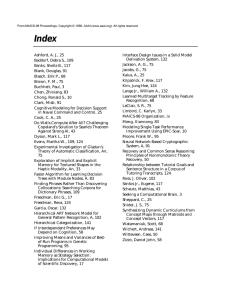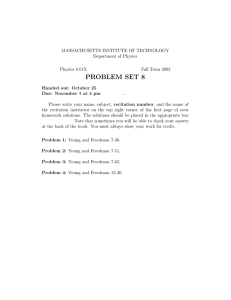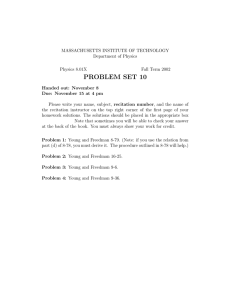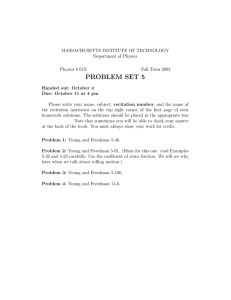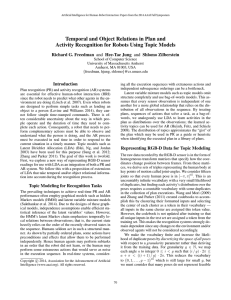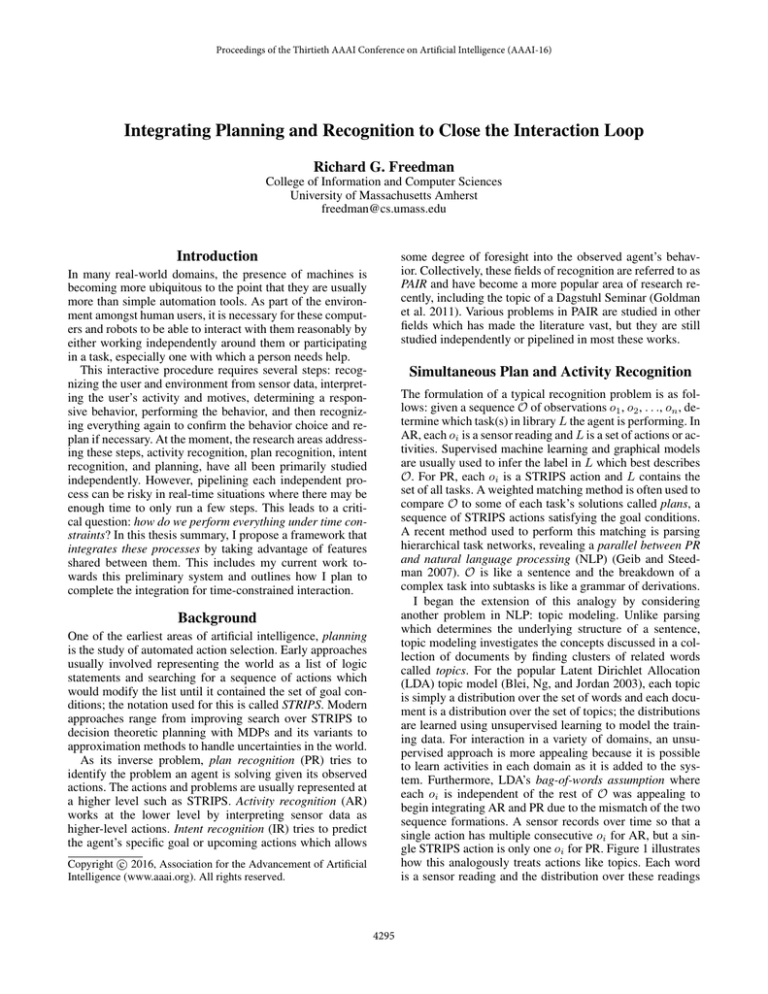
Proceedings of the Thirtieth AAAI Conference on Artificial Intelligence (AAAI-16)
Integrating Planning and Recognition to Close the Interaction Loop
Richard G. Freedman
College of Information and Computer Sciences
University of Massachusetts Amherst
freedman@cs.umass.edu
Introduction
some degree of foresight into the observed agent’s behavior. Collectively, these fields of recognition are referred to as
PAIR and have become a more popular area of research recently, including the topic of a Dagstuhl Seminar (Goldman
et al. 2011). Various problems in PAIR are studied in other
fields which has made the literature vast, but they are still
studied independently or pipelined in most these works.
In many real-world domains, the presence of machines is
becoming more ubiquitous to the point that they are usually
more than simple automation tools. As part of the environment amongst human users, it is necessary for these computers and robots to be able to interact with them reasonably by
either working independently around them or participating
in a task, especially one with which a person needs help.
This interactive procedure requires several steps: recognizing the user and environment from sensor data, interpreting the user’s activity and motives, determining a responsive behavior, performing the behavior, and then recognizing everything again to confirm the behavior choice and replan if necessary. At the moment, the research areas addressing these steps, activity recognition, plan recognition, intent
recognition, and planning, have all been primarily studied
independently. However, pipelining each independent process can be risky in real-time situations where there may be
enough time to only run a few steps. This leads to a critical question: how do we perform everything under time constraints? In this thesis summary, I propose a framework that
integrates these processes by taking advantage of features
shared between them. This includes my current work towards this preliminary system and outlines how I plan to
complete the integration for time-constrained interaction.
Simultaneous Plan and Activity Recognition
The formulation of a typical recognition problem is as follows: given a sequence O of observations o1 , o2 , . . ., on , determine which task(s) in library L the agent is performing. In
AR, each oi is a sensor reading and L is a set of actions or activities. Supervised machine learning and graphical models
are usually used to infer the label in L which best describes
O. For PR, each oi is a STRIPS action and L contains the
set of all tasks. A weighted matching method is often used to
compare O to some of each task’s solutions called plans, a
sequence of STRIPS actions satisfying the goal conditions.
A recent method used to perform this matching is parsing
hierarchical task networks, revealing a parallel between PR
and natural language processing (NLP) (Geib and Steedman 2007). O is like a sentence and the breakdown of a
complex task into subtasks is like a grammar of derivations.
I began the extension of this analogy by considering
another problem in NLP: topic modeling. Unlike parsing
which determines the underlying structure of a sentence,
topic modeling investigates the concepts discussed in a collection of documents by finding clusters of related words
called topics. For the popular Latent Dirichlet Allocation
(LDA) topic model (Blei, Ng, and Jordan 2003), each topic
is simply a distribution over the set of words and each document is a distribution over the set of topics; the distributions
are learned using unsupervised learning to model the training data. For interaction in a variety of domains, an unsupervised approach is more appealing because it is possible
to learn activities in each domain as it is added to the system. Furthermore, LDA’s bag-of-words assumption where
each oi is independent of the rest of O was appealing to
begin integrating AR and PR due to the mismatch of the two
sequence formations. A sensor records over time so that a
single action has multiple consecutive oi for AR, but a single STRIPS action is only one oi for PR. Figure 1 illustrates
how this analogously treats actions like topics. Each word
is a sensor reading and the distribution over these readings
Background
One of the earliest areas of artificial intelligence, planning
is the study of automated action selection. Early approaches
usually involved representing the world as a list of logic
statements and searching for a sequence of actions which
would modify the list until it contained the set of goal conditions; the notation used for this is called STRIPS. Modern
approaches range from improving search over STRIPS to
decision theoretic planning with MDPs and its variants to
approximation methods to handle uncertainties in the world.
As its inverse problem, plan recognition (PR) tries to
identify the problem an agent is solving given its observed
actions. The actions and problems are usually represented at
a higher level such as STRIPS. Activity recognition (AR)
works at the lower level by interpreting sensor data as
higher-level actions. Intent recognition (IR) tries to predict
the agent’s specific goal or upcoming actions which allows
c 2016, Association for the Advancement of Artificial
Copyright Intelligence (www.aaai.org). All rights reserved.
4295
Figure 1: Analogy of Distributions for Topics and Actions
Figure 2: Learned Clusters of Postures Resembling Sitting
describes an action while the task of the recording session
is represented by the distribution of actions. Hence inferring
a topic with LDA performs AR and the distribution of the
inferences enables us to approximate PR simultaneously.
After determining how to map RGB-D sensor readings
of three-dimensional stick figures to a space of words, I ran
LDA on a small dataset. The results provided evidence supporting my hypothesis since each topic contained postures
resembling simple actions as in Figure 2 (Freedman, Jung,
and Zilberstein 2014). We then extended LDA to consider
the presence of nearby objects and/or global temporal patterns and found evidence that the information provided by
these two factors are not only independent, but assist disambiguating actions which contain common postures (Freedman, Jung, and Zilberstein 2015). In future work, we will
investigate additional variations and their insights for PAIR.
Status of Thesis
I plan to close the interactive loop by completing the integration of these processes. Besides continuing the works
above, there are several key remaining tasks. The most important one is bridging the gap between simultaneous PR
and AR and the integration of PR with planning. Although
it seems trivial because both contain PR, they do not align
due to the unsupervised nature of topic models. Recognized
actions are clusters of postures without annotation while actions in the newer research are assumed to be in STRIPS
which is designed by humans. I have begun to identify methods for autonomously extracting features of the postures
with the greatest probability mass in each cluster and using
them to describe the respective action (Freedman and Zilberstein 2015). With Wallach, I am exploring analogies in topic
modeling. I have also spoken with Fukunaga about using
constraint optimization to align LDA clusters with STRIPS
operators using ordering of each O and these extracted features. After implementing and testing, it will be ideal to integrate IR to better predict upcoming actions so that the machine does not interfere with the observed user. For this, I
intend to investigate the planning graph and determine how
to probabilistically select action nodes which are more likely
to be executed. Once these are in tact, the preliminary interaction loop will be complete and optimization will be necessary to make it usable under realistic time constraints.
Integration of Planning with Plan Recognition
Ramı́rez and Geffner (2010) introduced a compilation of
PR problems into classical planning problems. It assigned
a distribution over L where Bayes’s Rule weighs the plans
against each other using the most optimal plans with and
without O as a subsequence. This accounts for the probability of the agent solving each task conditioned on its
observed actions, considering optimal (shorter) plans to be
more likely. While the accuracy for the method is very
strong, a temporal plot of the probabilities showed that it
only achieved this accuracy towards the completion of the
plan when the final actions were observed.
While their compilation is excellent when all the observed
actions are available, this is not as practical in interactions
because the observed agent will likely be in mid-execution
of a plan. In collaboration with Fukunaga (U. Tokyo), I have
proposed two approaches to address this (Freedman and
Fukunaga 2015). The first one generates a dynamic prior for
Bayes’s Rule that removes the bias for shorter plans and converges to the true prior over time. The second one counts the
number of permutations of a partially-ordered plan in order
to account for the number of optimal plans rather than their
length alone. The updated distribution over L can be used to
aggregate the lists of logic statements which must be true for
each goal and identify the most necessary conditions. If a set
of conditions is shared between the most likely tasks, then
satisfying them should be required regardless of the task.
Thus a second pass of the planner should yield a plan which
the machine may execute to interact properly even if the recognized task is still ambiguous. I developed a simulator for
a multiplayer version of the Sokoban game (a benchmark
in planning research) and we will begin implementing and
testing these methods within the next two months.
References
Blei, D. M.; Ng, A. Y.; and Jordan, M. I. 2003. Latent Dirichlet
allocation. Jour. of Machine Learning Research 3:993–1022.
Freedman, R. G., and Fukunaga, A. 2015. Integration of planning
with plan recognition using classical planners (extended abstract).
In AI for HRI: Papers from the AAAI 2015 Fall Symp., 51–59.
Freedman, R. G., and Zilberstein, S. 2015. Automated interpretations of unsupervised learning-derived clusters for activity recognition. In Wkshp. on Learning for Human-Robot Collaboration.
Freedman, R. G.; Jung, H.-T.; and Zilberstein, S. 2014. Plan and
activity recognition from a topic modeling perspective. In Proc. of
the 24th Int’l Conf. on Auto. Plan. and Sched., 360–364.
Freedman, R. G.; Jung, H.-T.; and Zilberstein, S. 2015. Temporal
and object relations in unsupervised plan and activity recognition.
In AI for HRI: Papers from the AAAI 2015 Fall Symp., 48–50.
Geib, C. W., and Steedman, M. 2007. On natural language processing and plan recognition. In Proc. of the 20th Int’l Joint Conf. on
AI, 1612–1617.
Goldman, R. P.; Geib, C. W.; Kautz, H.; and Asfour, T. 2011. Plan
Recognition – Dagstuhl Sem. 11141. Dagstuhl Reports 1(4):1–22.
Ramı́rez, M., and Geffner, H. 2010. Probabilistic plan recognition
using off-the-shelf classical planners. In Proc. of the 24th AAAI
Conf. on AI.
4296

